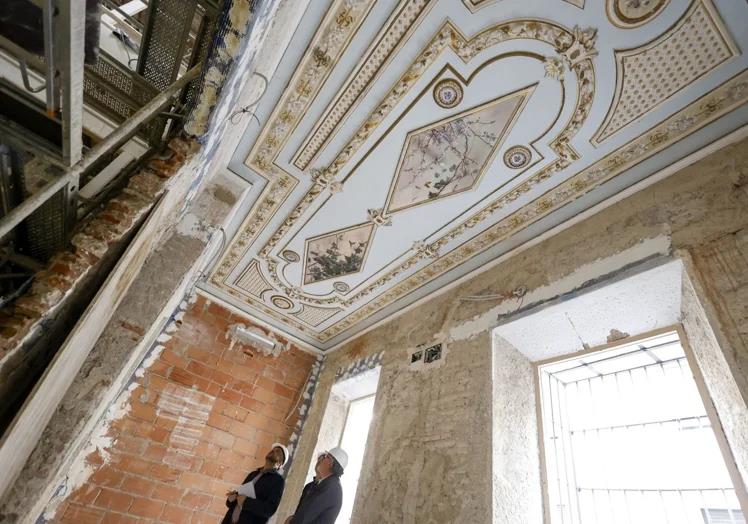
Sections
Highlight
Sections
Highlight

A mural, ceiling paintings and a medieval wall are among the findings during a year-long refurbishment project commissioned by Malaga's provincial authority at the Palacio de Valdeflores, located on Calle Carretería 60 in the city. Some baroque treasures were expected to be discovered, but what has now been revealed are their richness and ornamentation.
The detail and the motifs in these drawings, done only in shades of brown and at a time when the technical means for working on a facade of considerable height were precarious, are astonishing. The balconies and windows of the palace are framed by exuberant friezes with a profusion of rock carvings, vegetal elements and the pomegranate fruit, which appears on numerous occasions.
"We believe that these paintings were done freehand because there is nothing symmetrical," said Marina Albaladejo, one of the restorers who, together with Claudia Molero, have been patiently removing the paintings over the last few months. "We have discovered that there were some incisions in the wall that would act as a guide, but most of the drawings do not adhere to these marks. We think that several authors may have been involved," she added.
Guided by architect Rafael Salas Pulido, the restorers wanted to add as little as possible to the paintings, so only the areas where there was sufficient information about what the drawings looked like were completed. In the rest, only what has been recovered from under the layers of paint has been reconstructed.
However, this is not the only 'treasure' discovered during the process, which has been granted a budget of 1,592,781 euros. Inside, remains of the original paving of the palace stables have been discovered, as well as part of the barbican of the medieval city wall, which runs right along the axis of Carretería. In one of the rooms on the first floor, a section of this Muslim wall will be showcased behind a ventilated glass, where a curious vertical ceramic canalisation can be seen..
"It is possible that it was used as a fireplace," said Salas. The architect also showed the ceiling of an adjoining room in which, framed by diamond-shaped borders, two 1908 paintings by José Fernández Alvarado have been preserved. The Malaga-born artist was a disciple of Antonio Muñoz Degrain and José Moreno Carbonero. At the end of his life, he was the director of the Museum of Fine Arts in Huelva.

One of the paintings depicts almond branches and butterflies, while the other depicts vines and birds. Four perfectly preserved ceramic dishes are embedded in the decoration that frames the two works. The guillotine-style window mechanism with lead weights was also restored in the central courtyard windows of the building.
The Palace of Valdeflores was built in the mid-18th century and owes its name to Luis José Velázquez de Angulo y Cruzado (Malaga, 1722-1772), who in addition to being the second Marquis of Valdeflores, was a prolific archaeologist, historian and writer. As a member of the Royal Academy of History, he participated in the excavations at the Cártama site. He wrote about the origins of Castilian poetry, the annals of the Spanish nation up to the arrival of the Romans and the pre-Roman alphabets. During a three-year trip across the country, the Marquis of Valdeflores compiled the monumental history of the Peninsula.

The baroque palace was operated by the marquisate as an inn with stables. It had another owner a bit later, but there are no records. There are records to corroborate its use as a residence when in 1895 it was bought by the Countess of Albarede, who made several major alterations. Almost a century later (1985) and after passing through several hands, it was acquired and restored by the provincial authority, which opened there the provincial women's service, now located in the headquarters of the supra-municipal body, next to the Poniente promenade.
At the moment, the future of this building is still under study. What the president of the provincial authority, Francisco Salado, can confirm is that the building, with its wealth of façade paintings, will be a unique tourist attraction and a precious addition to Malaga's heritage.
Publicidad
Publicidad
Publicidad
Publicidad
Esta funcionalidad es exclusiva para registrados.
Reporta un error en esta noticia

Debido a un error no hemos podido dar de alta tu suscripción.
Por favor, ponte en contacto con Atención al Cliente.

¡Bienvenido a SURINENGLISH!

Tu suscripción con Google se ha realizado correctamente, pero ya tenías otra suscripción activa en SURINENGLISH.
Déjanos tus datos y nos pondremos en contacto contigo para analizar tu caso

¡Tu suscripción con Google se ha realizado correctamente!
La compra se ha asociado al siguiente email
Comentar es una ventaja exclusiva para registrados
¿Ya eres registrado?
Inicia sesiónNecesitas ser suscriptor para poder votar.